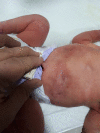Adams-Oliver syndrome, intestinal obstruction and heart defects: a case series of aplasia cutis congenita
- PMID: 35083055
- PMCID: PMC8787629
- DOI: 10.1093/omcr/omab141
Adams-Oliver syndrome, intestinal obstruction and heart defects: a case series of aplasia cutis congenita
Abstract
Aplasia cutis congenita (ACC) is a rare congenital defect described by the absence of skin and occasionally subcutaneous tissues or bone. The management of ACC varies depending on the lesion size, location and associated abnormalities. Small lesions often heal spontaneously, whereas larger lesions are significant and usually associated with additional anomalies in other organs. This paper reports three cases, which describe large lesions of ACC, presented with other abnormalities (Adams-Oliver syndrome, intestinal obstruction and heart defect). Particular attention should be paid to the patient with large lesions of ACC to investigate more congenital anomalies.
© The Author(s) 2022. Published by Oxford University Press. All rights reserved. For Permissions, please email: journals.permissions@oup.com.
Figures









References
-
- Brackenrich J, Brown A. Aplasia Cutis Congenita. In: StatPearls [Internet]. Treasure Island (FL): StatPearls Publishing, 2021, PMID: 30571024 Bookshelf ID: NBK535403. - PubMed
Publication types
LinkOut - more resources
Full Text Sources

